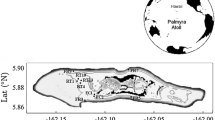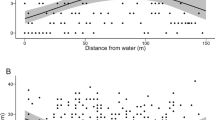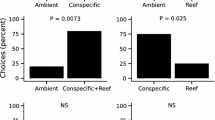Abstract
Numerous physical and biological factors have been identified which affect the probability of larvae settling on hard substrata. The spatial scale at which these factors operate ranges from km's to sub-mm's. The wide variety of cues that barnacle larvae respond to coupled with the subtleties of cue response to factors like surface roughness, suggests that larvae are fastidious in their choice of settlement sites and thus, (i) settlement is not rapid and, (ii) larvae carry out search behaviour to sample settlement cues. An experimental frame with settlement pits untreated or with either barnacle settlement factor, or cyprid settlement factor, or a squashed cyprid larvae were exposed for a duration of 10 minutes during the Semibalanus balanoide settlement season in the Clyde Sea, UK. A total of 102 of the 240 pits were settled within the 10 minutes. More settlement occurred in the chemically treated pits than the untreated pits suggesting that settlement can be both selective and rapid. Video-photography was carried out in the laboratory of the tracks of S. balanoides cyprids prior to settlement in pits. With untreated pits little search behaviour was identified, cyprids tended to encounter the pit and then settle. Pits treated with squashed cyprid showed a chemical cue-mediated behaviour with cyprids tending to slow down and carryout antennular crawling in the vicinity of the pit. The mean time from entering a 40× 40 mm window around the pit and settlement was 24.9 s ( n =11, SE = 5.4). Within the last 1.25 s prior to settlement, cyprids settling in untreated pits moved faster than cyprids settling in CL treated pits (P < 0.01), with a 4 times difference between the mean speeds These data suggest that settlement can be rapid and the pre-settlement track does not necessarily display search behaviour.
Similar content being viewed by others
References
Barnes, H., 1955. Further observations on rugophilic behaviour in Balanus balanoides(L.). Vidensk. Medd. fra Dansk naturh. Foren. 117: 341–348.
Becker, K., 1993. Attachment strength and colonization patterns of two macrofouling species on substrata with different surface tension (in situ studies). Mar. Biol. 117: 301–309.
Bertness, M. D., S. D. Gaines & R. A. Wahle, 1996. Winddriven settlement patterns in the acorn barnacle Semibalanus balanoides. Mar. Ecol. Prog. Ser. 137: 103–110.
Bourget, E., 1988. Barnacle larval settlement: The perception of cues at different spatial scales. In M. Vannini & M. Chelazzi (eds), Behavioural adaptations to the intertidal life. Plenum Press, NY.: 153–172.
Caffey, H. M., 1982. No effect of naturally-occuring rock types on settlement or survival inthe intertidal barnacle Tesseropora rosea(Krauss). J. exp. mar. Biol. Ecol. 63: 119–132.
Chabot, R. & E. Bourget, 1988. Influence of substratum heterogeneity and settled barnacle density on the settlement cypris larvae. Mar. Biol. 97: 45–56.
Clare, A. S., R. K. Freet & M. McClary, 1994. On the antennular secretion of the cyprid of Balanus amphitrite amphitrite, and its role as a settlement pheromone. J. mar. biol. Ass. U.K. 74: 243–250.
Connell, J. H., 1961. The influence of competition predtaion by Thais lapillusand other factors on natural populations of the barnacle Balanus balanoides. Ecol. Monogr. 31: 61–104.
Connell, J. H., 1985. The consequences of variation in initial settlement vs post-settlement mortality in rocky intertidal communities. J. exp. mar. Biol. Ecol. 93: 11–45.
Crisp, D. J., 1974. Factors influencing the settlement of marine invertebrate larvae. In P. T. Grant & A. M. Mackie (eds), Chemoreception in marine organisms. Academic Press, London: 177–265.
Crisp, D. J. & H. Barnes, 1954. The orientation and distribution of barnacles at settlement with particular reference to surface culture. J. anim. Ecol. 23: 142–162.
Dahlem, C., P. J. Moran & T. R. Grants, 1984. Larval settlement of marine sessile invertebrates on surfaces of different colour and position. Ocean Sci. & Eng. 9: 225–236.
Dineen, J. F. & A. H. Himes, 1994. Effects of salinity and adult extract on settlement of the oligohaline barnacle Balanus subalbidus. Mar. Biol. 119: 423–430.
Gabbot, P. A. & V. N. Larman, 1987. The chemical basis of gregariousness in cirripedes: A review (1953-1984). In A. J. Southward (ed.), Barnacle biology. A. A. Balkema, Rotterdam: 377–388.
Grosberg, R. K., 1982. Intertidal zonation of barnacles: the influence of planktonic zonation of larvae on vertical distribution of adults. Ecology 63: 894–899.
Hills, J. M. & J. C. Thomason, 1996. A multi-scale analysis of settlement density and pattern dynamics of the barnacle Semibalanus balanoides. Mar. Ecol. Prog. Ser. 138: 103–115.
Hills, J. M. & Thomason, J. C., 1998b. On the effect of size, surface area and larval behaviour on recruitment pattern and density of the barnacle (Semibalanus balanoides). Biofouling (in press).
Hills, J. M. & J. C. Thomason, 1998a. The effect of scales of surface roughness on the settlement of barnacle (Semibalanus balanoides) cyprids. Biofouling 12: 57–69.
Holmes, S. P., C. J. Sturgess & M. S. Davies, 1997. The effect of rock-type on the settlement of Balanus balanoides (L.) cyprids. Biofouling 11: 137–147.
Hui, E. & J. Moyse, 1987. Settlement patterns and competition for space. In A. J. Southward (ed.), Barnacle biology. A.A. Balkema, Rotterdam: 363–376.
Keough, M. J. & P. T. Raimondi, 1996. Responses of settling larvae to bioorganic films: Effects of large-scale variation in films. J. exp. mar. Biol. Ecol. 207: 59–78.
Knight-Jones, E. W. & D. J. Crisp, 1953. Gregariousness in barnacles in relation to the fouling of ships and to antifouling research. Nature 171: 1109–1110.
Larman, V. N. & P. A. Gabbot, 1975. Settlement of cyprid larvae of Balanus balanoides and Elminius modestus induced by extracts of adult barnacles and other marine animals. J. mar. biol. Ass. U.K. 55: 183–190.
Lewis, C. A., 1978. A review of substratum selection in free-living and symbiotic cirripeds. In F. S. Chia & M. E. Rice (eds), Settlement and metamorphosis of marine invertebrate larvae. Elsevier, NY. 207–218.
Le Tourneux, F. & E. Bourget, 1988. Importance of physical and biological settlement cues used at different sptial scales by the larvae of Semibalanus balanoides. Mar. Biol. 97: 57-66.
Maki, J. S., D. Rittschof, J. D. Costlow & R. Mitchell, 1988. Inhibition of attachment of larval barnacles, Balanus amphritrite, by bacterial surface films. Mar. Biol. 97: 199–206.
Minchinton, T. E. & R. E. Scheibling, 1991. The influence of larval supply and settlement on the population structure of barnacles. Ecology 72: 1867–1879.
Miron, G., B. Boudreau & E. Bourget, 1995. Use of larval supply in benthic ecology: testing correlations between larval supply and larval settlement. Mar. Ecol. Prog. Ser. 124: 301–305.
Miron, G., E. Bourget & P. Archambault, 1996. Scale of observation and distribution of adult conspecifics: their influence in assessing passive and active settlement mechanisms in the barnacle Balanus crenatus(Brugiè re). J. exp. mar. Biol. Ecol. 201: 137–158.
Moore, P. G. & Y. M. Wong, 1995. Activity and trapping characteristics in the field of Orchomene nanus(Krø yer) (Amphipoda: Lysianassoidea) at Millport, Scotland. J. exp. mar. Biol. Ecol 189: 143–157.
Mullineaux, L. S. & C. A. Butman, 1991. Initial contact, exploration and attachment of barnacle (Balanus amphitrite) cyprids settling in flow. Mar. Biol. 110: 93–103.
Mullineaux, L. S. & E. D. Garland, 1993. Larval recruitment in response to manipulated field flows. Mar. Biol. 116: 667–683.
Noda, T. & S. Nakao, 1996. Multi-scale spatial pattern of recruitment in the barnacles Semibalanus cariosuson the Kameda peninsula, southern Hakkaido, Japan. Hydrobiologia 324: 125–130.
O'Connor, N. J. & D. L. Richardson, 1994. Comparative attachment of barnacle cyprids (Balanus amphitriteDarwin 1854; B. improvisusDarwin 1854; & B. eburneusGould 1841) to polystryene and glass substrata. J. exp. mar. Biol. Ecol. 183: 213–225.
Pineda, J., 1994. Spatial and temporal patterns in barnacle settlement rate along a southern California rocky shore. Mar. Ecol. Prog. Ser. 107: 125–138.
Raimondi, P. T., 1990. Patterns, mechanisms, consequences of variability in settlement and recruitment of an intertidal barnacle. Ecol. Monog. 60: 283–309.
Rittschof, D., E. S. Branscomb & J. D. Costlow, 1984. Settlement and behaviour in relation to flow and surface in larval barnacles, Balanus amphitriteDarwin. J. exp. mar. Biol. Ecol. 82: 131–146.
Thomason, J. C., J. M. Hills, A. S. Clare, A. Neville & M. Richardson, 1998. Hydrodynamic consequences of barnacle colonisation on hard substrata. Hydrobiol. (this volume).
Varley, M. J., M. J. W. Copland, S. D. Wratten & M. H. Bowie, 1993. Parasites and predators. In S. D. Wratten (ed.), Video techniques in animal ecology and behaviour. Chapman & Hall, London: 33–63.
Voris, H. K., W. B. Jefferies & S. Poovachiranon, 1994. Patterns of distribution of two barnacle species on the mangrove crab, Scylla serrata. Biol. Bull. 187: 346–354.
Walker, G. & A. B. Yule, 1984. Temporary adhesion of the barnacle cyprid: the existence of an antennular adhesive secretion. J. mar. biol. Ass. U.K. 64: 679–686.
Walters, L. J. & D. S. Wethey, 1996. Settlement and early postsettlement survival of sessile invertebrates on topographically complex surfaces: the importance of refuge dimensions and adult morphology. Mar. Biol. Prog. Ser. 137: 161–171.
Weissburg, M. & R. K. Zimmer-Faust, 1991. Effects of chemoreception and hydrodynamics in mediating predation. Am. Zool. 31: 103.
Wethey, D. S., 1984. Spatial pattern in barnacle settlement: day to day changes during the settlement season. J. Mar. Biol. Ass. UK 64: 687–698.
Yen, J. & J. R. Strickler, 1996. Advertisment and concealment in the plankton-what makes a copepod hydrodynamically conspicuous. Invert. Biol. 115: 191–205.
Yule, A. B. & D. J. Crisp, 1983. Adhesion of cypris larvae of the barnacle Balanus balanoides, to clean and arthropodin treated surfaces. J. mar. biol. Ass. U.K. 63: 261–271.
Yule, A. B. & G. Walker, 1985. Settlement of Balanus balanoides: the effect of cyprid antennular secretion. J. mar. biol. Ass. U.K. 65: 707–712.
Rights and permissions
About this article
Cite this article
Hills, J.M., Thomason, J.C., Milligan, J.L. et al. Do barnacle larvae respond to multiple settlement cues over a range of spatial scales?. Hydrobiologia 375, 101–111 (1998). https://doi.org/10.1023/A:1017029627006
Issue Date:
DOI: https://doi.org/10.1023/A:1017029627006




